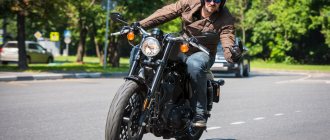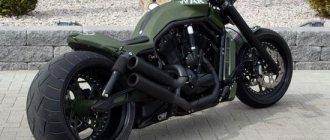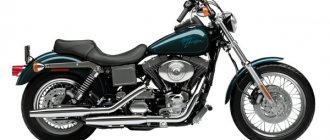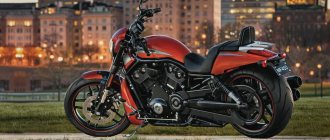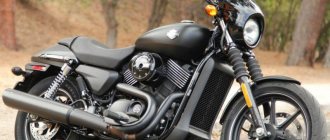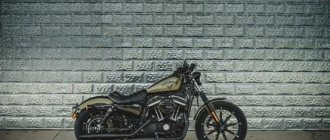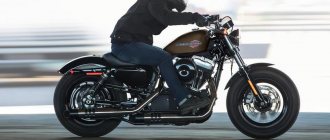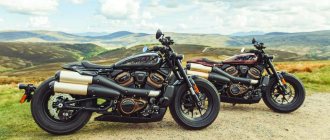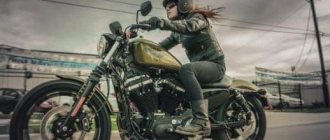history of the company
The history of Harley Davidson deserves special attention. It is one of the most successful firms that has ever existed. The company began in 1903. It was in this year that Davidson and Harley released their first bike. They soon founded a small company and began producing about 50 motorcycles a year. Over time, they began to introduce innovative developments into their products: V-Twin engine, manual transmission. Even in the earliest times, Harley-Davidson products had their famous, highly visible shape.
The company withstood difficult crises for the American economy, produced more than 80 thousand units of equipment for the US military needs during the Second World War and remained afloat. Currently, Harley Davidson produces about 200,000 motorcycles per year. It is also noteworthy that the community of motorcyclists under the auspices of the company is the largest in the world.
Harley Davidson Sportster 1200
Motorcycles of this model are the most common. Buyers are attracted to them not only by their appearance, but also by their relatively affordable price. The Sportster is the lightest model in terms of weight and handling. Its frame is narrower and more compact than that of classic models, and provides better maneuverability on the roads.
The first Sportster motorcycle appeared in 1957 in order to satisfy the interests of those who wanted to purchase a sports bike. The developers tried to achieve ideal characteristics, and they succeeded. The new frame, equipped with engine balancing shafts, is more rigid and durable, and the 2-piston brakes have also been improved. The cooling system has also been improved. Increasing the engine speed gave it additional power. The ignition system has also undergone modernization. At the same time, Harley has not changed its classic brutal style at all. The ease of handling makes the Harley Davidson Sportster 1200 ideal for urban riding.
Harley-Davidson XL1200 Sportster Custom. Sports equipment
The first Harley-Davidson Sportster appeared in 1957 and was conceived as a sports equipment for flat track, drag racing and other racing popular in those years in the USA. Let's see how this model has evolved after almost 60 years
Natalia Umnova
Harley-Davidson XL1200 Sportster Custom. Price: from 1,034,000 rub. On sale: since 2015
It's hard to imagine, but in the distant past, Harley-Davidson motorcycles often won podiums at various competitions. Today, only one name remains of the Sportster sports component, but the family of motorcycles has grown and includes seven models: 883 Roadster, Superlow, Forty-Eight, Iron 883, Superlow 1200T, Seventy-Two and 1200 Custom, which will be discussed. The “Sportsters” differ from each other, as they say, only in their outlook on life - in their body kit and engine: partly there is a V-twin 883 cm3, and partly - a 1200 cc unit.
The Sportster 1200 Custom, as you might guess, is equipped with a 1200 cc V-engine that produces 96 Nm of torque. Harley-Davidson traditionally does not indicate the number of “horses”, because it believes that this figure is not indicative for motorcycles of this class. But we understand everything!
Be that as it may, the power and torque of the engine are quite enough to accelerate the compact and relatively light (only 268 kg of curb weight) device, ensure safe overtaking and beautiful starts from traffic lights. And also, when you start the motorcycle, it vibrates almost like the legendary Dyna (which, by the way, “crawls away” from a stop not as far as the owners like to embellish in stories), and this vibration does not completely disappear while riding, but is quite felt both in the arms and in the legs. But this is the idea of the engineers, because it is obvious that by the 21st century they could solve the problem of engine vibrations if they wanted. It’s just that their task is not only to make a working, driving machine, but also to place a classic “true” soul in its classic iron shell.
But it’s not just the engine that’s responsible for the “old-school” look—the designers also did a great job, and they came up with a harmonious, beautiful motorcycle. True, beauty is not always synonymous with comfort. For example, the driver's seat itself is comfortable, but together with the centrally located footrests it does not form the most successful seating position with a slightly unnatural, tense forward tilt (for a driver up to 180 cm tall). The footpegs themselves make it difficult to move the motorcycle with your feet - this is a problem for all “central pegs”. The passenger seat is no good at all: small and sloping backwards. Although it is clear that such motorcycles are not made for riding together. Nevertheless, designers and marketers are hinting in every possible way at a thick catalog of tuning (and even inserted the word “custom” into the name of the model), which presents an assortment of footpegs, seats, handlebars and everything else. Whatever you say, you rarely see a stock Harley on the road: customization for these motorcycles, especially classic ones, is an almost obligatory step after purchase.
When describing most Harley-Davidson motorcycles, it is difficult to focus on technical parameters, but there is no particular need: “Harley” is not about ultra-modern technologies, electronic assistants, original solutions or fine-tuned settings (for example, the front suspension of the Sportster 1200 Custom works “excellently” , and the back one is “B”, it ruins everything!). “Harley” is about the emotions that each specific motorcycle of the brand evokes. And sometimes it doesn’t—well, okay, he’s completely self-sufficient without it.
| Harley Davidson Specifications | |
| Dimensions (length/saddle height) | 2225×725 mm |
| Base | 1530 mm |
| Ground clearance | 105 mm |
| Fuel tank volume | 17 l |
| Engine | 1202 cm3, 4-stroke, 2-cylinder, V-twin, air-cooled, injector, 96/3750 Nm/min-1 |
| Transmission | mech., 5-speed, drive - belt |
| Frame | steel, tubular |
| Front suspension | telescopic fork |
| Rear suspension | pendulum, two shock absorbers |
| Front/rear brake | 1 disc / 1 disc, ABS |
| Dry weight | 268 kg |
The editors recommend:
How to reduce washer fluid consumption?
Russians will be able to catch traffic violators on their phones
Where is it better to store a car - in a garage or outside? Opinions for and against
Advanced truck driver and savings on service: what do cargo carriers rely on?
New law: fine drivers for speeding 5 km/h
News Media2
Discussion Cancel
I want to receive the most interesting articles
Specifications
Harley Davidson Sportster 1200 has excellent technical characteristics. It is equipped with a 1200 cubic centimeter V-engine that produces 96 Nm of torque. The motorcycle is considered the lightest among Harleys and weighs 268 kilograms. The amount of horsepower varies depending on the model and year around 58-66 units. This is quite enough to provide the Harley Davidson Sportster 1200 with acceleration to 100 km in 4 seconds. With this time, you can start beautifully from a traffic light and impress observers.
The technical characteristics of the Harley Davidson Sportster 1200 allow it to reach speeds of up to 175 km/h, but the operating speed is lower - around 160. Fuel consumption, depending on the route and driving style, is 5-7 liters per 100 kilometers. This model also has a rather impressive gas tank with a volume of 17 liters, which helps you travel a certain amount of distance without refueling.
The developers also did a great job on the appearance of the Harley Davidson Sportster 1200. The motorcycle looks so proportionate and harmonious that you want to immediately get on it and ride, conquering more and more new roads.
motorcycle strangers
Good afternoon, people!
My name is MadMax. I own an XL1200S motorcycle.
My topic called “Gasoline, consumables, fasteners” has long existed on one of the popular motorcycle sites. It must be said that it has long outgrown the “short pants” of the popularly chattering motorcycle community and in some places has turned into an outright trash bin.
Here I will talk about the XL1200S model and describe the process of setting up and operating the motorcycle, fortunately, all this is still to come. Also, I will ask questions to “experienced” Harley riders. I will be consistent and meticulous in discussions. I hope this helps someone in the future. For those who are looking to buy any Sportster - after all, the “Sport” model contains almost all the family features of the Sportster family.
Therefore, we need to tell you a little about S
The Sport modification appeared in the Sportster family in 1996. Consigned to history in 2003. I just have a copy from the last year, 2003.
Here, in the photo, it is only after purchase, not yet cleared of the “husks” (back, reflectors, stupid stickers).
In 1998, the model underwent a slight refresh. Double spark plug heads, an electronic ignition module appeared, and the brakes were improved.
Well, in fact, the following features distinguish the S from other Sportsters:
— Delphi electronic ignition: — two-plug heads (many say that from Buell - I haven’t seen confirmation of this anywhere; the coil is 4-pin, respectively); — compression ratio 10.0 (other Sportsters before 2003 had 8.7 and 9.0); — “high” camshafts (I won’t write the markings yet, it’s hardly interesting); — “leaky” carburetor jets (accelerator pump included); — MAP sensor instead of VOES, which everyone else has; — Adjustable Showa suspension (both front and rear); — double-disc front brake; — 13-spice cast wheels; — “factory” tachometer.
Otherwise, +/- the usual Sportster. Rigid mounting of the engine in the frame (“rigid”).
Oh yes! Horses - 69 at 5500 rpm ("electronic collar" at 5500 - we'll discuss later!!), maximum torque - 103 Nm at 4000 rpm. But that's according to the book. If I’m in a good mood, I’ll go to the stand in the summer.
Tank - “pistachio”, 12.5 liters before reserve. The remote controls, steering wheel, mirrors, and steering column covers are painted black. The steering wheel is narrow. HD 100th anniversary badges on the tank. !! There is also an anniversary badge on the block. Framed with a piping in the crankcase casting - spenders (or show-offers??)!!
Rumor has it that the Model S was originally positioned as an over-Sportster/under-Buel. That is, a road motorcycle for those who love the Sportster, but do not want to put up with its very mediocre performance. Hence the slightly “tightened” engine and adjustable suspensions and, in general, a normal semi-finished product for an upgrade according to the owner’s temperament. Let's just say that it has reserves for tuning. If you take a regular Hagger or Custom, it will take more money to bring him to his senses. In 1998, the motorcycle was updated. Just then they added 2-plug heads and a new ignition. It seems that the model was not in demand by buyers; few people wanted to pay extra from 600 to 800 dollars for dubious (according to ordinary people) advantages. Therefore, by 2003, it was closed under the guise of another modernization of the family. The successor to the S was the R modification with its 883R and 1200R models. It must be said that these were not the same semi-finished products...
But in 2008, the XR1200 was released. Well what can I say? It's like when the Ford RS came back. It seems nonsense, but it’s nice.
I like the color. Metallic. I don’t remember exactly what it’s called in Harley.
At first I thought of repainting it brutal black. Then I gave it to a friend for a ride and decided to look at the motorcycle in motion. The brake light on the blue fender looks very cool. In general, I won't repaint it.
The color is awesome. I like
That's how he is. Fast motor.
Let's continue our research.
I would definitely like to express my opinion about the vibrations of the power plant. Let me remind you that the fasteners in the frame are rigid.
On a warm engine, in idle mode, you can see how the front wheel jumps along with the fork. The engine runs erratically - this is its normal condition.
When accelerating without load (not in motion) around 4000 rpm, a wave of vibrations resonates from the far points of the motorcycle to the speedometer and tachometer. It's similar to how a dog shakes itself off after swimming in a river. Around 5000 rpm, the layer of leather on the driver's seat resonates. Yes Yes. Imagine. I'm not talking about silencers. With a sharp release of gas, they sway left and right like a cucumber in a glass (instead of the word “cucumber” you can use a stronger word - well, you get the idea). I was surprised that even (!!) the gas tank cap vibrates. Her rattling was infuriating at first.
The movement has its own characteristics. In WOT mode, teeth can pop out in the range of 3500-4500 rpm. Hands “dry” approximately here. That is if they are naked. Wearing gloves reduces the effect. I use special army gloves with soft inserts. I have enough. Otherwise, you can get used to it. * the fifth point is always under massage *
This is the norm. For an engine with a forked connecting rod and a 45 degree camber, this is normal. There are no balance shafts here. We will massage (forgive me, Russian, for the mockery).
The myth of Harley vibrations ceased to exist for me. I understood the extent and type of this effect. Jackhammer? Yes. Is it stressful? No. In short, in my opinion this issue is not worth close attention. Let yourself tremble. It's made that way. It doesn't bother me to live. I open the swimming season on Cosmonautics Day.
In the first kilometers, many parts of the hitch and their fasteners wanted to run away from me. There will be a separate post about this. Although vibrations were the root cause.
PS: when stopping at a traffic light, willy-nilly I hear from a vibrating motorcycle (read at a fast pace): “Let's go, let's go, let's go, let's go, let's go, let's go, let's go, let's go!!!!" A minute of waiting turns into an eternity. It is unpleasant to stand and wait on it. He just pushes you to “stick” the first one and unscrew all the bolts... No motorcycle before has produced such an effect. On the contrary, I liked the way they booed at x.x. the Japanese and even the Urals!
Here's an observation. Is it good or bad? Don't know. Cool feature. But... There are no silencers for the taste and color...
A little about the jambs:
It was a nice summer day. The mood was great. I was driving along Kutuzovsky to the city center. In the left lane, 120-130 km/h, as usual.
There were no signs of trouble, when suddenly the “tidy” fell with a crash onto the headlight visor. She began to thrash about him terribly. I immediately grabbed it with my left hand and, without slowing down, continued moving. This happened at the fork with Dorogomilovskaya, at the entrance to the tunnel.
The middle rows were blocked by some stupid buses that walked in a column and were accompanied by chipboard cars (today is June 12th - a holiday, the city center is blocked). They walked so tightly that at my speed I could not wedge myself into the column. And I couldn’t leave the “tidy” either. Some Bentley-Schmentleys started to hit me in the back. In short, I had to fly right up to the beginning of New Arbat (Kalinin Avenue).
Only then I turned right and stopped in the wrong place. I began to think about how to go further (a person was waiting for me at the appointed time).
There were a couple of bags from the supermarket in the backpack. I pulled the “tidy” with them. I placed the gloves between the “tidy” and the visor (so as not to fight), and drove on. Got to the meeting on time.
Special thanks to the girl on the scooter (unfortunately, I didn’t ask her name and... phone number - I’m married), who stopped to help me. __________________________________________________________________________
What do we have in the bottom line?
"Unfortunate." to the awesome people for working on the exterior. The bracket is clearly flimsy for two weighty devices. The vibrations of the Ridged Mount, Moscow roads and the console did their job. The motorcycle is new. Mileage - about 2500 km. The year is 2003.
It's a shame, Yo I'll have to make homemade brackets.
Moral of the story:
Guys, owners of Sport-s, R-s and other Sportsters with such tidy - Be careful! If it happens, don't be surprised.
About the accident:
SMACKED
No, not like that.
SQUARRED. No... not that either...
Wow, exactly. 3.14 FUCKED (I apologize for the rudeness)…
Almost got a strike. Two guys and an Alfa Romeo. Harley and I missed the skittles by half a meter.
Classic. Wheel lock on dusty tiles. I went on business at lunchtime. Returned to the workshop. Re-braked. He fell on his left side. We slipped about 5-6 meters. Harley is a little further away from me. My jeans, jacket, and left boot are dirty. The rear left turn signal on the Harley was worn out, its glass flew out and cracked. The left steering wheel grip is worn. The driver's left footrest is worn. The clutch lever is jammed (straightened it out with a screwdriver). And, worst of all, the adjustment of the gear change mechanism was disrupted. He got out of control. The fact is that when sliding, the motorcycle rested, among other points, on the gear shift paw, bending it upward. Judging by the deep grooves on the tile, the weight of the motorcycle seriously pushed down the gear change shaft. The defect showed: the shaft is straight, the foot is intact, the gears engage poorly, neutral is practically not found
I kept the oil that I changed literally three hundred years ago. I'll pour it back in.
Well what can I say? Got upset. But they didn’t give up.
After the end of the working day, I removed the primary gear cover and adjusted the mechanism. Oh, what a boring job this is. The fact is that it needs to be adjusted with the clutch removed. I think you guessed that I succeeded without removing it. Well, I don’t want to disassemble half a motorcycle.
But I’ll say one thing right away - I give the HD engineers “satisfactory” for the layout of the body parts and primary transmission mechanisms of the Sportster. with a minus. There is no German school on them!
First things first... After the fall, it became difficult to engage the gears, neutral was difficult to catch (just like on a Yamaha), in short, the shift adjustment was lost.
The manual describes in detail the process of adjusting the entire mechanism (using a drill as a gauge), but... it involves removing the clutch, because it is located behind it in the housing. Of course, you don’t want to do this, since the process is very labor-intensive and lengthy. Besides, my professional instinct told me that everything was not so hopeless.
Stock up on this trough (slide 1). It will always help you to “preserve” the oil. Of course, the oil was changed about 200 km ago, pouring in a new one is not in the style of post-apocalyptic Australia. To do this, thoroughly clean the container and degrease it. As you can see, I use an antifreeze canister. You can also use the old sump from the automatic transmission - it’s cooler
Drain the oil after heating it. “Warming up” means driving a few kilometers, not a hundred meters, as many naively believe. It is necessary to fry the oil to its operating temperature (60-80 degrees) so that it leaves the crankcase better. It is enough to drive about 10-15 kilometers around the city, with frequent acceleration and braking - the operating modes of the clutch, and therefore the generation of heat when sliding.
Saved the oil. Remove the primary gear cover. I won't describe it in detail. Everything works out quickly there even intuitively. The only thing that can make life easier during removal (and later during installation) is removing the clutch cable from the cover. The chain guide (shoe) must be loosened to the limit so that the cover can come off more easily. Take a 22mm wrench for the nut and a 1/4 hexagon. Move the shoe away from the chain by unscrewing the rod (slide 2).
Carefully remove the pressure and its nuts with the spring. Put the lid seal aside, don’t throw it away, it will come in handy.
And further. You MUST place some cardboard meter by meter under the oil container. You will save the oil, but you will heavily damage the floor or ground with oil leaks from the crankcase - it is better to immediately protect yourself from long exercises with sawdust and a broom.
Remove the cover - assess the condition of the “sub-axial space”. Is anything unscrewed, are there any powder shavings in the crankcase cavities, etc. What is the size of the “hedgehog” on the drain plug? Can't you see what's gnawing on something? In short, take the time, you won’t regret it. Everything was clean with me, except for the sparkles of metal on the cork. I think this is a product of the contact between the starter ring and the switch.
This is where the fun begins. The base of the switch is held in the housing by two nuts (slide 3).
The plate they hold has elongated holes that allow you to select the desired angle of the switch plate. A crutch is attached to this plate, pushing the copy shaft. And the shift shaft (the one that we press with our left foot) is connected to this plate with a lever. It’s tricky, but when you see it with your own eyes (live or in a manual), you’ll understand everything. In principle, the scheme is classic. Why adjust the mechanism? The fact is, this is necessary to coordinate the kinematics of the mechanism and the housing in which it is installed. Due to inaccuracies in manufacturing and machining, gaps in the hinges of the mechanism, it is required to set it to “zero”. This operation is standard for such mechanisms. An analogy can be drawn with the mode change mechanism in the automatic transmission and the PRNDL interior selector...
I loosened the nuts, put the plate in the middle position and began to adjust the mechanism (slides 4 and 5).
The idea is simple - to achieve a clear engagement of neutral and, since everything is done with the engine turned off, a clear engagement of the “neighboring” neutral gears - first and second. The retainer, as seen in the manual, looks like a flower petal. Locked with a hanging roller.
MUST... Achieve full engagement of first and second gears. You can “stick” passes with punches. You can and should help fork 1-2 move the wheels completely into place. To do this, you can roll the motorcycle back and forth in one of the gears or (this is a little more difficult) help the fork with your hand, as if to bring it to full gear engagement (slide 6).
It's hard to see on the slide. You will see everything live. In general, you need to help the fork with your hand to move not 20, not 50, but 100% of its travel. As you understand, the wheel engagement in this case is completely normal.
OK. We achieved this. What's next? And then comes the adjustment. Look for a position for installing the plate in which it is easy to put neutral in both 1st and 2nd gears, the gears themselves are easily engaged, there is no misalignment or misalignment. It's not very easy, but in real life everything works out quite quickly. To get normal sensations, place the shift tab on the shaft and try moving the lever with your foot. I guarantee that you will find the right position quickly enough.
In addition, in ordinary life such adjustments are made when assembling the engine, when replacing parts, or when individual parts are damaged. I had a fall, which led to a “chatter” in the mechanism. This is sad, but most likely, with the same next fall, the paw will “float away” again. We'll keep thinking. Maybe it’s worth installing arcs...
Did you find the position of clear clicks and engagements (watch the fork)? OK, tighten the nuts to 8-10 Nm and smoke.
It's time to put everything back together (preferably the next day). Clean the flanges on the engine cover and crankcase. BE SURE to degrease them. Take the old gasket. Don't degrease it. The aggressive composition can devour it. Just dry it thoroughly with an absorbent cloth. I take responsibility for not changing the gasket. It won't leak, believe me. The maximum is to sweat locally. Of course, later (in winter) we will change the gasket. Clean the lid bolts in nefras (slide 7).
Don't lose the pins and do everything in reverse order. When you install the cover, protect the shaft seal from damage. Wrap the splines and the step on the shaft with tape, it’s a cheap job, and the cuff will be guaranteed to be intact (slide 8).
Carefully lean the lid, do not forget about the pins. Tighten the bolts according to the diagram in the manual. Relying on my experience, I tightened the torque to 5-8 Nm “cross-on-cross”. Don't mix up the bolts. Three dimensions. Two large ones hold the driver's footrest, 4 - two on the pins and the upper, “fat” part of the cover, the rest - everywhere. I am writing because there have been cases when somewhere a bolt does not fit, it is pulled until it is stupefied, somewhere two threads do not hold and the thread also breaks.
Have you collected it? Click the paw without adding oil or straining the chain.
All the same? nothing escaped? Great.
Roll the motorcycle back and forth, engage one of the gears (the wheels in the gearbox will take a new position and move apart). Look for neutral from 1st and 2nd. Are there any jumps from 1 to 2 and vice versa? No? So, OK. Does the neutral click clearly? Yes? OK. Is there a lack of inclusion felt? Well, that is, you press your foot, but nothing happens? No? OK.
2 weeks and about a thousand kilometers have passed since the adjustment. There's something to be said.
For adjustments “blindly” or “by touch” the result is excellent. Both cold and hot, neutral is found perfectly, it doesn’t jump. The clamp securely fixes the copy shaft. The gears switch on clearly.
There is also a negative connotation. Switching “up” does not seem to be completely complete - about 80-90% of the shaft rotation. The joint between the cover and the crankcase does not leak, and neither does the cuff. Only a couple of inter-bolt spans at the bottom are sweating. Well, the gasket is old. I'll change it in winter. Need to order. ______________________________________________________________
And in winter I will adjust the mechanism “according to the book” by removing the clutch. Walk - just walk
About gasoline.
If you don’t remember my long ordeals with choosing a brand of gasoline and don’t stir up the topic “Gasoline, consumables, fasteners,” then at the moment, after many city and highway kilometers, I give preference to the AI-98.
You remember about the engine - the compression ratio is 10.0. About recommendations “from a book” - too. I tried refueling with 95, 98, 95 and 98 in different ratios, turning the ignition and analyzing the operation of the engine (catching detonation, adjusting the carburetor, looking at the condition of the spark plugs, heating of the heads, etc., etc.).
So, my choice for the XL1200S is the AI-98. With this gasoline, the engine does not overheat as much as with 5th gasoline and runs smoother. Dynamic performance is satisfactory, consumption is normal. The condition of the candles is normal.
The 95th was not satisfied with its 92nd origin. The engine got hotter even in highway mode (one of the signs of a low octane fuel number), worked unstably, and sometimes detonated. Don't forget about adjusting the ignition; there is no knock sensor here.
In addition, I had to “fill in” the IA-95 a couple of times. After a certain number of operating cycles, the motor sneezed and twitched. On the threaded part of the spark plug (which indirectly signals the quality of the fuel and the degree of “dumping” - so-called jetting) not soot accumulated, but, I would even say, plaque. Black hard coating, like pieces of ice.
In other words, maybe the AI-95 (and in some cases the 92nd) is good for Sportster engines, but for the “pressed-up” XL1200S engine, in my opinion, the AI-98 is excellent.
And further. I would not recommend refueling at dense gas stations, gas station clones or gas stations like Horseradish (Gay-, Duper-, Super-) Oil, and even more so, buying “95 at 20 per liter” from Uncle Vasya , fuel truck driver. Take this issue seriously. For several years now I have been refueling at one branded gas station, which is not exactly close to my house, but at a short distance. The gas station belongs to a large domestic oil-producing concern, which clearly monitors the quality of work of its gas stations in the capital. The engines of all the cars and motorcycles that consumed that gasoline never gave any reason to doubt their PROPER quality.
Speed characteristics of the XL1200S.
I finally found the gear ratios for my motorcycle. Constructed a speed characteristic. Americans also call it saw-tooth diagram. Drive wheel size - 130 / 90 - 16.
The red line indicates the value of the maximum engine crankshaft speed. Green—peak engine torque. Blue lines indicate gears from I to V. You can also observe several calculation tables - the total gear ratio (first table), the progression of adjacent gears, the maximum speed in each gear, the number of revolutions when changing to the next gear (in wide open throttle mode).
Tested in practice. It fits. I cranked the engine until the cutoff in the first three gears - the calculated speeds coincided.
The diagram shows a huge II-III gap. And so it is. The range, for my taste, is not divided rationally. I would lower the number II and increase the number III. Then dynamic acceleration in WOT (wide open throttle) mode would be smoother and more rolling. And so - I turned on the first one until the cutoff, the second - I turned one and a half - already switched, the third - and the locomotive started moving. The most unpleasant moment is the protracted (long) acceleration in “three”. Then - “four” and everything is generally sluggish. But this is normal - the speeds have already increased. There, completely different processes are taking place and the force of resistance is seriously growing.
I see no apparent reason for this breakdown. Although, we should not forget that only developers know all 70% of the known information about the product. And there can be quite a lot of reasons for choosing exactly these numbers and breakdowns. Let's put it another way: I (emphasis) are not entirely comfortable with these numbers in my environment.
Soon I will try the motorcycle at maximum speed. I think we'll get 175-180.
Don't forget! The speedometer moves up by 5-10% depending on the speed. The true speed is ALWAYS LOWER than indicated by the speedometer, this is inherent in the design. Wheel circumference 130 / 90 - 16 measured on a motorcycle.
* we are thinking about a tuning block with a “collar” not for 5500, but for 6800 and 7200 * * of course, I want to “expand” the “native” block *
I immediately remember the guys who “went 190 in their Sportster without bending down.” Storytellers. Or tuning?
Sources:
https://harleyforums.ru/forum/viewtopic.php?f=20&t=33&sid=db1045064e4d86700931d10bf2b4ddfb https://harleyforums.ru/forum/viewtopic.php?f=4&t=17&sid=db1045064e4d86700931d10bf2b4 ddfb
Advantages and disadvantages
Like any vehicle, Harley is not without its shortcomings. But you can’t find too many of them:
- high cost of original spare parts;
- small seat (suitable for only one passenger);
- specific size of bolts with inch threads.
Otherwise, this is a real treasure on wheels:
- excellent brakes (both front and rear);
- large and comfortable mirrors;
- fast acceleration;
- attractive appearance;
- economical fuel consumption;
- comfortable fit and comfortable steering wheel;
- suspension that will not be afraid of Russian roads;
- modern cooling system.
Well, the story of how I acquired a Harley-Davidson 1200 Sportster Custom (there are some other letters there and I really don’t remember, may Harleyists forgive me...))) and why, I described here. I didn’t drive it enough to tell you in detail about its operation, only 11,000 km, but I especially remembered a couple of moments. All photos are mine, purely to dilute the text.
Episode one. ABS
New Harleys already have ABS, keyless entry, etc., etc.
So, I somehow started the motorcycle, started moving, but the ABS light did not go out, I called the dealer and said, they say: I've got a problem((((, PAMAGITE(((((. They didn’t accept me right away, I signed up, I arrived. They diagnosed that something... then it's worn out, you need to order and change it. But you can go, no big deal, it's a mere trifle: there's just no ABS. To be honest, I wasn't upset and went with the thought: well, we once drove before (and even now) without ABS , that means I can do it too. It’s true that the motorcycles we had before didn’t cost like the Cast Iron Bridge from Harley-Davidson.)))
I don’t remember who lit who, but it looks like a Honda Harley))) (Honda has a battery in the trunk)
I'll come back for a replacement after some time. They change. And they reassure me that this is the first time this has happened to Harley. That you were simply “lucky” to be chosen!!!
Time passes, I needed to clarify something in the service: whether to sign up for maintenance, or to install some kind of add-on, it doesn’t matter. I'm calling and asking to connect me with the receptionist. Connect. I recognize a familiar voice and say: “Good guy, remember me, I’m the “Chosen One” whose ABS is worn out?!” The answer is awesome: “I don’t remember, every second person here wears out their ABS…”)))
Episode two. Trade-in, sale.
I remember how I traded in Harley and I remember how long they had it there, for a very long time. So long that when I arrived for the next maintenance, I saw how bored Harley was. By the way, they sold it for exactly as much as it was given to them.
They called me once from a Harley-Davidson dealer, and I recognized that voice, it was the voice of the person who told me that I was the “Chosen One” ....))), and said that here we have your Sprat, which you We handed it in for trade-in, tell me, why did you take it apart?
Well, I was taken aback.
The conversation continued. They say the person bought it, it was “peeing” with oil and its sealant was clearly not factory!
The second time I was taken aback!
In general, my assurances that I was in the service three times and three times only with you, at Morpheus, clearly did not find a response.
As a result, I even called the Motorrad manager and said that everything was fine with the bike, and I didn’t touch anything except the gas tank cap and the steering wheel)
What amazing chrome on Harley!!!
It is clear that they did not present any complaints to me, and I did not say that some kind of sediment remained, but I remembered these two episodes for a long time. He says I’m not vindictive, I’m just angry and I have a good memory)))
By the way, is it purely legally possible to make a claim?
Best regards, PostmanEG
Owner reviews
Motorcyclists speak of the Harley-Davidson 1200 not just well, but with real love. Rest assured, if you bought this bike, you won’t be able to get away with easy sympathy. This is a motorcycle for the soul. If you're a fan of sportbikes rather than choppers, then this won't appeal to you. But if you are a fan of a leisurely and “soulful” ride, then you will like the smooth rumble of the engine and the classic appearance.
The raised steering wheel keeps your hands from getting tired, and the ease of control makes the Sportster 1200 ideal for urban conditions. Among the disadvantages, owners note the stiffness of the suspension, which almost does not soften the unevenness of the road. Motorcycle parts are of high quality. The virtually indestructible gearbox and excellent brakes will not soon require replacement after purchase. The only things that upset the owners are the too stiff clutch, which you have to get used to, and the forced loneliness on the road due to the small seat. Otherwise, if the Harley is looked after and faults are corrected in a timely manner, it will serve its owner for many years.
